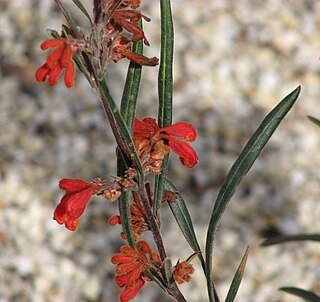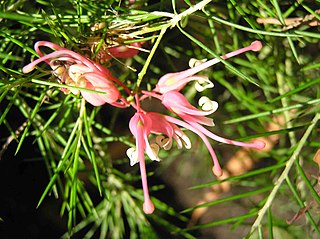
Grevillea obtusifolia, commonly known as obtuse leaved grevillea, is a species of flowering plant in the family Proteaceae and is endemic to the south-west of Western Australia. It is a spreading to dense, prostrate shrub with oblong to narrowly elliptic leaves and clusters of eight to twelve, pink or red flowers.

Grevillea centristigma is a species of flowering plant in the family Proteaceae and is endemic to the south-west of Western Australia. It is a low, compact to erect, rounded or spreading shrub with softly-hairy narrowly elliptic to egg-shaped leaves with the narrower end towards the base, and deep yellow to orange flowers with a yellow, later brick-red style.

Grevillea bronweniae is a species of flowering plant in the family Proteaceae and is endemic to the south-west of Western Australia. It is an erect shrub usually with more or less linear leaves, and wheel-like clusters of crimson flowers.

Grevillea glossadenia is a species of flowering plant in the family Proteaceae and is endemic to Queensland, in northeastern Australia. It is an erect shrub with more or less elliptic leaves and deep yellow-orange to orange-red flowers.

Grevillea celata, commonly known as Nowa Nowa grevillea or Colquhoun grevillea, is a species of flowering plant in the family Proteaceae and is endemic to a restricted part of Victoria in Australia. It is an erect and open to low, dense shrub with oblong, broadly elliptic or linear leaves, and red and yellow, or red, white and apricot-coloured, sometimes all yellow flowers.

Grevillea diversifolia, the variable-leaved grevillea, is a species of flowering plant in the family Proteaceae and is endemic to the south-west of Western Australia. It is an erect to prostrate shrub with simple or divided leaves and groups white to cream-coloured flowers with a dull red style.
Grevillea hockingsii is a species of flowering plant in the family Proteaceae and is endemic to south-eastern Queensland. It is an erect shrub with oblong to narrowly elliptic leaves and clusters of reddish-pink flowers.

Grevillea evanescens is a species of flowering plant in the family Proteaceae and is endemic to the south-west of Western Australia. It is an erect to spreading shrub with oblong to elliptic leaves and clusters of pale to bright red and cream-coloured flowers.

Grevillea granulosa is a species of flowering plant in the family Proteaceae and is endemic to the south-west of Western Australia. It is a low, spreading shrub with linear leaves and red to orange flowers in clusters of up to eight.

Grevillea kenneallyi is a species of flowering plant in the family Proteaceae and is endemic to the south-west of Western Australia. It is a dense, spreading shrub with divided leaves, the end lobes more or less linear, and clusters of white flowers.

Grevillea fasciculata is a species of flowering plant in the family Proteaceae and is endemic to the south-west of Western Australia. It is a low, often spreading shrub with narrowly elliptic to more or less linear leaves and erect clusters of red and orange or orange and yellow flowers.
Grevillea cheilocarpa is a species of flowering plant in the family Proteaceae and is endemic to a restricted area in the south-west of Western Australia. It is a shrub with silky-hairy, egg-shaped leaves with the narrower end towards the base, and yellow flowers.

Grevillea coccinea is a species of flowering plant in the family Proteaceae and is endemic to the south of Western Australia. It is a low-lying or sprawling shrub with narrowly wedge-shaped to linear leaves and white, cream-coloured, and red or yellow flowers.

Grevillea deflexa is a species of flowering plant in the family Proteaceae and is endemic to inland areas of central Western Australia. It is a shrub with linear to elliptic or egg-shaped leaves, and groups of red, yellow or red and yellow flowers.

Grevillea extorris is a species of flowering plant in the family Proteaceae and is endemic to the west of Western Australia. It is an erect shrub with linear or narrowly oblong leaves and clusters of pink to red or yellow flowers.

Grevillea fistulosa, commonly known as Barrens grevillea or Mount Barren grevillea, is a species of flowering plant in the family Proteaceae and is endemic to the Fitzgerald River National Park in the south-west of Western Australia. It is an erect shrub with narrowly egg-shaped to broadly linear leaves and clusters of orange-red to scarlet flowers.
Grevillea fuscolutea is a species of flowering plant in the family Proteaceae and is endemic to a small area in the south-west of Western Australia. It is an erect shrub with egg-shaped to more or less linear leaves, and dull yellow-orange flowers.

Grevillea gordoniana is a species of flowering plant in the family Proteaceae and is endemic to the west of Western Australia. It is an erect shrub or small tree with cylindrical leaves and yellow to orange flowers.

Grevillea hislopii is a species of flowering plant in the family Proteaceae and is endemic to a restricted area of the south-west of Western Australia. It is a dense, single-stemmed shrub with linear to narrow elliptic leaves and clusters of hairy, whitish-grey flowers.
Grevillea nivea is a species of flowering plant in the family Proteaceae and is endemic to the south of Western Australia. It is a dense shrub with spreading to ascending branches, crowded, divided leaves, the end lobes linear, and dense clusters of red flowers.

















